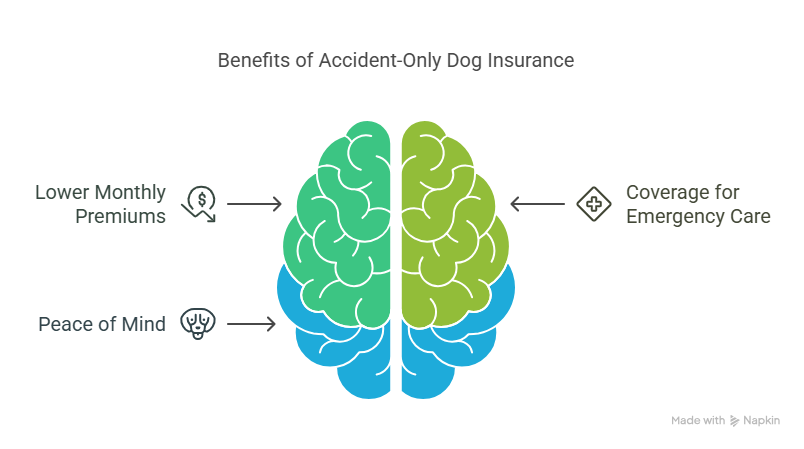The pleasures and costs of taking care of your pet are probably nothing new to you as a pet owner. Given that owning a dog typically costs between $1,000 and $2,000 a year, it’s no surprise that many dog owners are using pet insurance to help pay for veterinary care.
In order to guarantee that their dogs get the finest treatment possible without going over budget, a significant portion of pet owners in the US are now purchasing pet insurance. The market for pet insurance is really expanding quickly, and a variety of policies are available from several providers to accommodate varying demands and price ranges.
For pet owners who want to properly manage their budget, it is essential to comprehend the monthly expenses related to pet insurance. Numerous variables, like the dog’s age, breed, health, and location, might affect the price.
The average monthly cost of pet insurance for a dog
It’s critical for pet owners to know how much dog insurance typically costs each month. The kind of coverage, the age and breed of the dog, and the owner’s location are some of the variables that might affect the price.
Average Costs by Type of Coverage
The monthly premium is greatly influenced by the kind of coverage selected. Plans that solely cover accidents are often less expensive, with monthly averages between $20 and $40. Depending on the amount of coverage, comprehensive plans—which cover both diseases and accidents—can cost anywhere from $40 to $100 a month.
Cost Variations by Dog Breed and Age
The dog’s age and breed have a significant impact on insurance premiums.Premiums are often higher for older dogs and certain breeds that are more likely to have health problems. A young dog in good condition, for instance, would cost $30 to $50 a month to cover, but an older dog or a breed with recognized health problems might cost $70 to $150.
Regional Differences in Prices Throughout the US
Due to regional variations in the cost of veterinary treatment, insurance premiums may also range.Premiums are often greater in urban regions than in rural ones. For example, the cost of pet insurance may be higher for pet owners in major cities like New York or Los Angeles than for those in rural or small villages.
| Coverage Type | Average Monthly Cost |
|---|---|
| Accident-Only | $20-$40 |
| Comprehensive | $40-$100 |
| Wellness Add-ons | $10-$30 |
Factors Influencing Your Monthly Premium for Pet Insurance
Making educated selections about your dog’s coverage requires knowing the elements that affect your monthly pet insurance price. The amount you will pay each month for your dog’s insurance depends on a number of factors.
Breed-Specific Health Hazards and How They Affect Prices
Your insurance premium may be greatly impacted by the health problems that certain dog breeds are more likely to have. For example, bigger breeds like Great Danes may be more prone to hip dysplasia, whereas breeds like Bulldogs and Pugs are more likely to have respiratory issues.
The following are the main health hazards for common breeds:
- enlarged hips in bigger breeds
- Eye issues in species such as Chihuahuas and Poodles
- Heart problems in breeds like Bulldogs and Boxers
How Your Expenses Are Affected by Deductibles and Reimbursement Levels
The amount you must fork over before your insurance coverage begins is known as the deductible. Because you are paying a larger portion of the upfront cost, a greater deductible usually translates into a cheaper monthly premium. On the other hand, since the insurance company is bearing a greater portion of the upfront risk, a smaller deductible results in higher rates.
Levels of reimbursement are also quite important. You will pay more each month if you choose a higher reimbursement level (such as 90%), but you will get more complete coverage in the event that your dog requires medical attention.
| Deductible | Reimbursement Level | Monthly Premium |
|---|---|---|
| $250 | 80% | $45 |
| $500 | 80% | $35 |
| $250 | 90% | $55 |
The Impact of Annual Coverage Limits on Monthly Payments
The maximum amount that your insurance company will pay out in a given year is determined by annual coverage limitations. Because they provide more thorough protection, policies with larger coverage limits usually have higher monthly rates.
Your monthly premium may be cheaper if you choose a coverage with a smaller yearly limit, but you may have to pay more out of pocket if your dog needs expensive treatment.
Recognizing the Costs of Various Coverage Options
There are several types of dog pet insurance, such as full coverage, wellness add-ons, and accident-only policies. Selecting the best plan that suits your demands and your budget requires an understanding of these possibilities.
Accident-Only Plans: The Cheapest Choice
The least expensive kind of dog insurance is an accident-only coverage, which usually costs $20 to $50 a month. Unexpected veterinarian costs brought on by mishaps like fractured bones or foreign item ingestion are covered by these programs.
The main advantages of accident-only policies
- Reduced monthly premiums
- coverage for unexpected veterinarian emergencies
- Calm for unforeseen circumstances

Complete Coverage: Benefits of Higher Premiums
Comprehensive coverage gives your dog more complete protection by covering both sickness and accidents. Depending on your dog’s age, breed, and medical issues, complete coverage might cost anywhere from $40 and $100 per month.
The benefits of all-inclusive coverage
- includes coverage for both diseases and accidents.
- Greater attention to chronic conditions
- Greater amounts of reimbursement
| Coverage Type | Monthly Cost | Key Features |
|---|---|---|
| Accident-Only | $20-$50 | Covers accidents, emergency care |
| Comprehensive | $40-$100 | Covers accidents, illnesses, chronic conditions |
Are Wellness Extras Worth the Higher Monthly Price?
Routine care, including immunizations, dental cleanings, and preventive drugs, are covered by wellness add-ons. Usually, these extras run between $10 and $30 a month.
Advantages of wellness accessories:
- covers regular medical costs
- encourages the use of preventative care
- able can be included into current plans
Common Exclusions to Be Aware Of
Knowing what your dog insurance coverage does not cover is crucial. Pre-existing diseases, health problems unique to a breed, and cosmetic operations are common exclusions.
Examining the exclusions in your policy:
- Conditions that already existed
- Health problems unique to a breed
- Cosmetic operations

Conclusion: Choosing Pet Insurance That Fits Your Budget
Knowing the variables influencing your monthly pet insurance rates is essential to selecting the best plan for your dog. You may make an educated choice that works within your budget by taking into account the kind of coverage, breed-specific health concerns, deductibles, reimbursement levels, and yearly coverage restrictions.
As you can see, the price of pet insurance varies greatly depending on a number of criteria, such as the location, breed, and age of your dog. Comprehensive coverage offers more broad protection at a greater cost, while accident-only insurance are the most economical choice. Your insurance may also be improved with wellness add-ons, but these come with a higher monthly fee.
Consider both your financial status and the particular requirements of your dog in order to make the best choice. Examine the products and services offered by several insurance companies to choose a plan that strikes a balance between price and coverage. By doing this, you can make sure your dog gets the care they need without breaking the bank.
FAQ
How much is pet insurance for a dog per month on average?
The average monthly cost of pet insurance for dogs can range from $20 to $50, depending on factors such as the dog’s age, breed, and health conditions, as well as the type of coverage chosen.
What factors affect the cost of dog insurance per month?
Several factors can impact the monthly cost of dog insurance, including the dog’s age, breed, health, and location, as well as the type of coverage, deductible, and reimbursement level chosen.
Are there any regional variations in dog insurance costs across the United States?
Yes, dog insurance costs can vary by region due to differences in the cost of veterinary care, regional health risks, and other factors.
How do deductibles and reimbursement levels impact my monthly pet insurance premium?
Higher deductibles and lower reimbursement levels can result in lower monthly premiums, while lower deductibles and higher reimbursement levels typically increase premiums.
What is the difference in cost between accident-only plans and comprehensive coverage?
Accident-only plans are generally less expensive, with lower monthly premiums, while comprehensive coverage is more costly but provides broader protection against a range of health issues.
Are wellness add-ons worth the extra monthly cost?
Wellness add-ons can be beneficial for maintaining your dog’s health through regular check-ups and preventative care, but whether they are worth the extra cost depends on your dog’s specific needs and your budget.
How do breed-specific health risks affect pet insurance costs?
Breeds prone to specific health issues may have higher insurance premiums due to the increased risk of claims related to those conditions.
Can I customize my pet insurance plan to fit my budget?
Yes, many pet insurance providers allow you to adjust your coverage, deductible, and reimbursement level to balance your premium costs with the level of protection you need.
What are common exclusions in pet insurance policies that I should be aware of?
Common exclusions include pre-existing conditions, certain breed-specific conditions, and sometimes age-related issues, so it’s essential to review your policy’s terms carefully.
How can I determine the best pet insurance plan for my dog?
To find the best plan, consider your dog’s age, health, breed, and your budget, and compare different insurance providers’ coverage options, costs, and exclusions.




